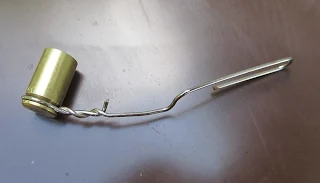He asked me to look into reloading. A box of .410 shells costs about four times as much as economy 12 gauge shells.
Reloading shotgun shells
There is a dazzling amount of reloading data for shotgun shells. Not only are there many different kinds of powder, there are also major difference in pressure due to wads and hulls and primers. Incidentally, wads are the plastic part that separate the powder and the shot charge. Hulls are the outside of the shotgun shell and primers are the impact sensitive part that the firing pin hits to start the firing sequence.
It can be overwhelming.
My approach is to simplify things. For a given powder, is there a 'window' of powder amounts that will work with an assortment of wads and primers? Rather than arbitrarily pick a velocity, wad, hull, powder and primer I ask myself: Is there a 'load' that will accommodate a wide range of components should I find myself in an environment where I am lucky to find any kind of usable component?
I call that 'load' The Forgiving Zone
It is necessary to reduce the universe of variables a little bit. The data displayed in the chart shown above is for ONE type .410 hulls, one type of powder and one shot charge. The hull is Winchester HS. The powder is H-110, also sold as Win-296. The load is 1/2 ounce of shot.
The minimum powder weight listed by Hodgdon's for each wad/primer combination is plotted by the blue line.
The maximum powder weight listed by Hodgdon's for each wad/primer combination is plotted by the red line.
A box is drawn that shows the range of powder weights that are allowable for all listed primers and wads. In this case I can almost randomly choose a .410 wad and shotgun primer, dump between 15.5 and 16 grains of H-110 powder into the case and a half ounce of shot in the wad and know that I will have a safe, effective .410 load.
Choosing your failure modes
Why did I add the qualifier "almost"? Because I only plotted CCI M209, Fed 209A and Win 209 primers. Hodgdon's listed a little bit of data for Rem 209P primers but I chose to not plot that data.
The reason I left out the Rem 209P data is because the Remington primers ran significantly lower pressures and velocities than the others and including them meant that there was no "forgiving zone". The upside of leaving out the Remington primers is that if I were forced to to use Remington primers in my loads, the loads would "fail" by being low speed rather than over-pressure. It was a matter of choosing the potential failure mode I can live with.
The other reason for "almost" is because it is impossible to list every wad that is available to the reloader. Many of them are knock-offs of big-name wads but even so there are likely to be differences in dimension, plastic composition and such.
Two cent solutions to $20 problems
 |
| Home made powder measure |
The solution was to take a spent 40 S&W casing. The virgin case dropped about 19 grains of H-110. I opted to shorten the case with a flat, bastard file. If you are not comfortable with using a file you can dribble glue or pack epoxy putty into the case to reduce its volume. For my case, my lot of H-110 powder and using my powder scale, I had to shorten the case to 0.700" or approximately 17.5mm to get it so it dropped between 15.5-and-16.0 grains of H-110. I am offering those numbers as guidance. Your spent 40 S&W shell might have more or less internal capacity. Use at your own risk.
Then I needed a handle. My fingers are fat and the shell can get slippery. Twas not great trick to make one out of a large paperclip.
I will be ready to rock and roll as soon as my wads show up.


ERJ- what do you estimate the cost to be?
ReplyDelete